
Apple has released WatchOS 26 to the public beta, after roughly six weeks of developer beta access. I’ve been using it since the announcement last month at WWDC, and have a pretty good feel for the new features, both minor tweaks, as well as the larger tweaks. This includes the new glass-like UI (called Liquid Glass), the ability to sync Notes, as well as fitness-focused features like Workout Buddy and the redesigned user interface.
Now obviously, it’s still in beta (just expanding availability from developer beta to public beta), with the ultimate release slated for this September, likely alongside new watches. As always, except that the new features introduced in the WatchOS 26 beta are only a portion of the new things that ultimately end up in WatchOS 26 when it hits both new and old watches this fall. That’s because Apple always holds back certain features to announce at their September event, and many times these features are available across more than just the newly announced watches.
Note that WatchOS 26 is available for Apple Watch Ultra 2, Ultra 1, Series 10, Series 8, Series 7, Series 6, and SE (2nd Gen).
In any case, let’s get into it.
All the General Bits:
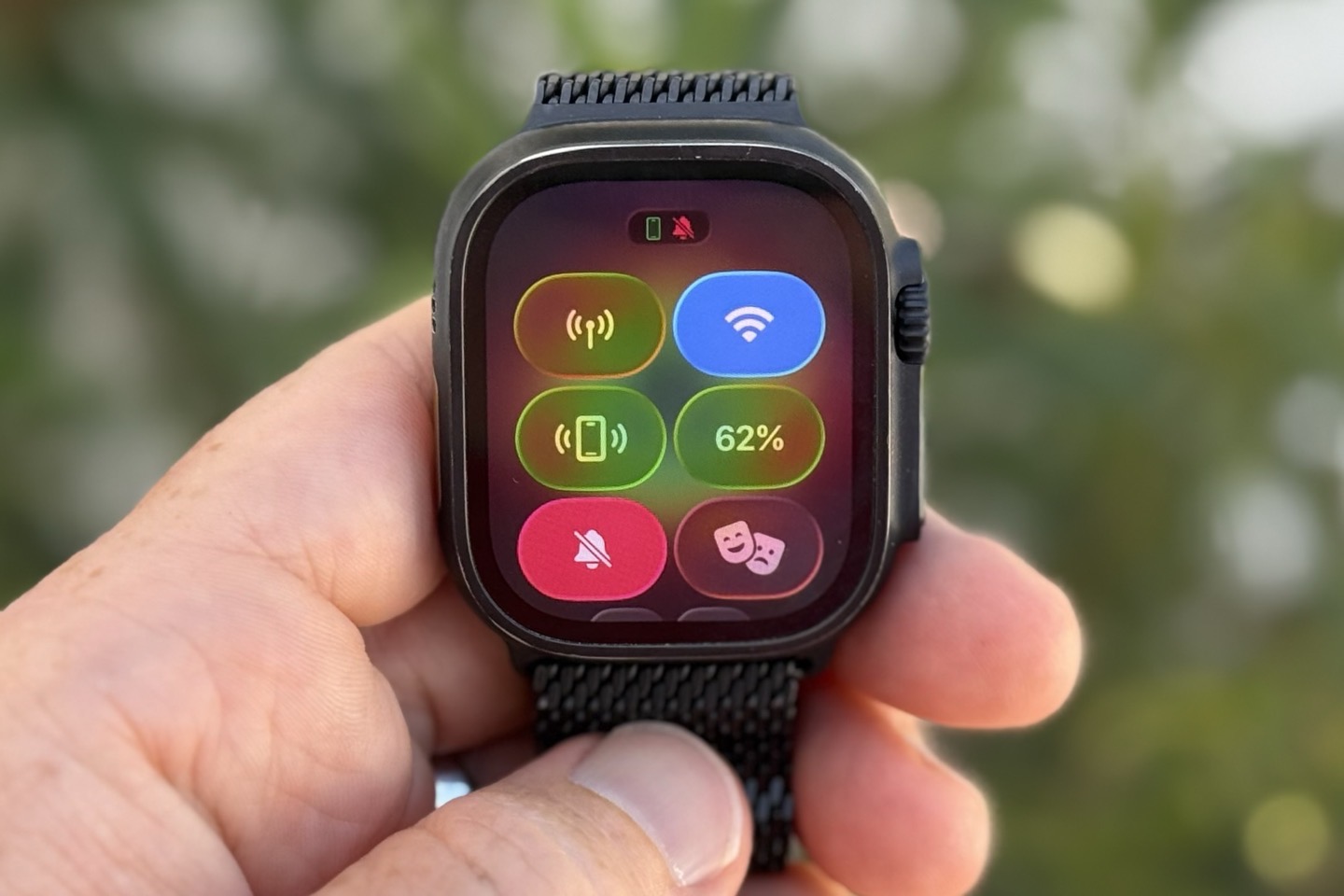
First up, a super quick recap on what’s new in this realm (for non-workout features):
– New Liquid Glass design style, including translucence, across the UI
– Added automatic volume adjustment, changing notification levels based on ambient noise (e.g., if in a noisy place, it’ll increase notification levels)
– Added wrist flick option to mute calls and do other quick actions
– Added automatic call screening feature (seen/announced too for iOS 26)
– Added hold assist for calls, which will keep calls on hold (detecting background music), and notify you when a human arrives
– Added live language translations in Messages app on watch
– Added configurable widgets
– Added automatic smart actions to Messages, such as sharing your location if a conversation implies it wants it
– Added Notes app to Apple Watch, letting you see your existing notes, and add to them
– Revamped Smart Stack again, to be better at predicting things. For example, if you walk into your gym as part of a routine, it learns to offer the Workout app when you do so
– Added Controls Widget API for developers
Many of these things are pretty minor, though ironically, probably my favorite is simply the sync of Notes from my phone to the watch. It’s super handy for stuff like grocery lists or the like. I often write down a list of shots I need when out running/riding, and having them quickly accessible is nice. Or here, where I’m using the phone to take the shots, and thus, being able to glance at the watch is handy.
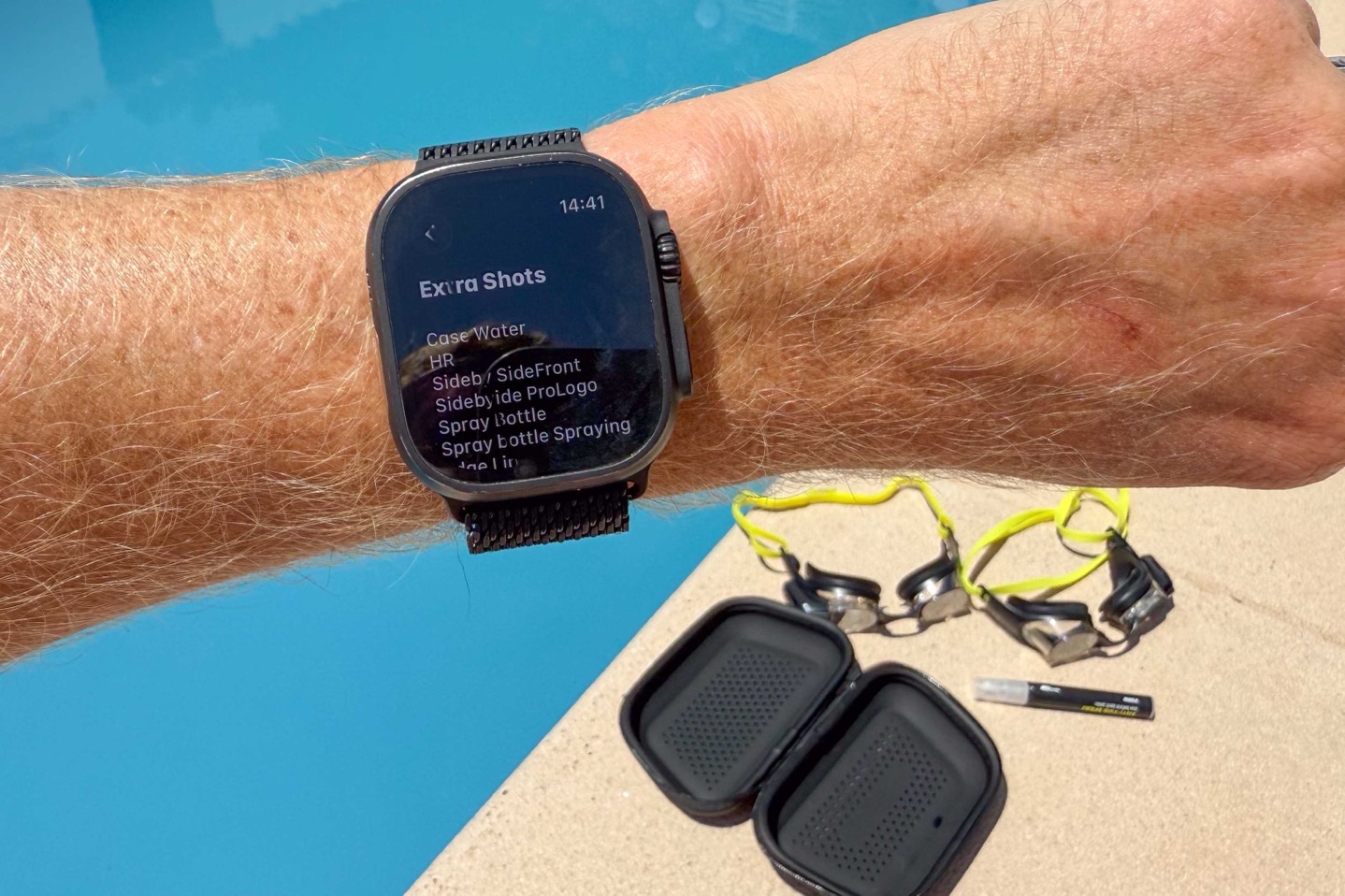
You can view existing notes, and create a new note, but there isn’t any way to modify an existing note (such as crossing off the completed shots). Perhaps that’ll come down the road, I don’t know (or perhaps there’s some non-obvious way to edit said existing note).
As for the Liquid Glass-like interface, it’s pretty toned down compared to iOS 26 (and even that has been toned down in the most recent beta). But since the WatchOS 26/iOS 26 announcement, the WatchOS side of things was always much more muted, likely as a result of just being a heck of a lot smaller screen, designed for quick glanceability. So, having too much transparency makes it harder to see things (and likely a reason why we saw Apple tone it down on the phone side too).
Anyway, overall, on the watch specifically, I don’t think most people will really care one way or the other. The most visible instance of Liquid Glass is frankly the PIN code/unlock screen.

Everything else is pretty muted.
New Workout User Interface:
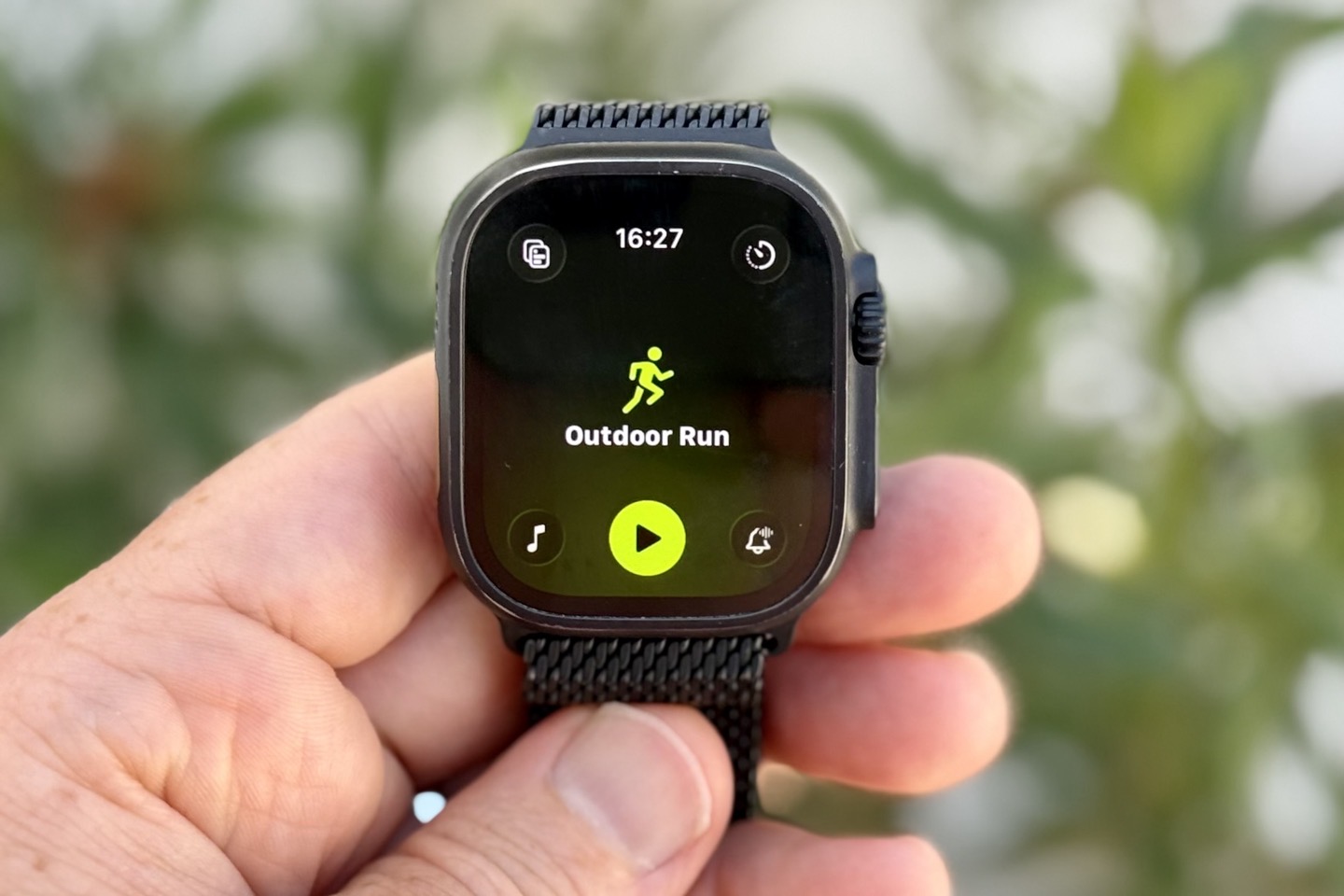
Ok, so let’s get into some of the workout interface changes. These are arguably some of the bigger pieces, which distill down into the following:
– Revamped Workout UI entirely
– Added Personalized Workout Media, music feature will automatically offer a playlist to ‘fit’ the workout (e.g., based on intensity)
– Added Workout Buddy for workout encouragement (English only at launch)
– As part of the Workout UI revamp, made custom workouts & racing bits more accessible
Essentially, this boils down to: ‘rearranging a bunch of bits into more logical buckets’, adding a new Apple Music feature, and adding Workout Buddy.
Starting off with the Workout User Interface revamp, the first thing you’ll notice is that it’s simply showing a single sport at a time (seen above), whereas in the past, you had 2-3 tiles worth of sports (e.g., Running, Cycling, Swimming, etc…). However now, when you scroll, it then uses Liquid Glass to show roughly three workout types at a time, as you go up/down:
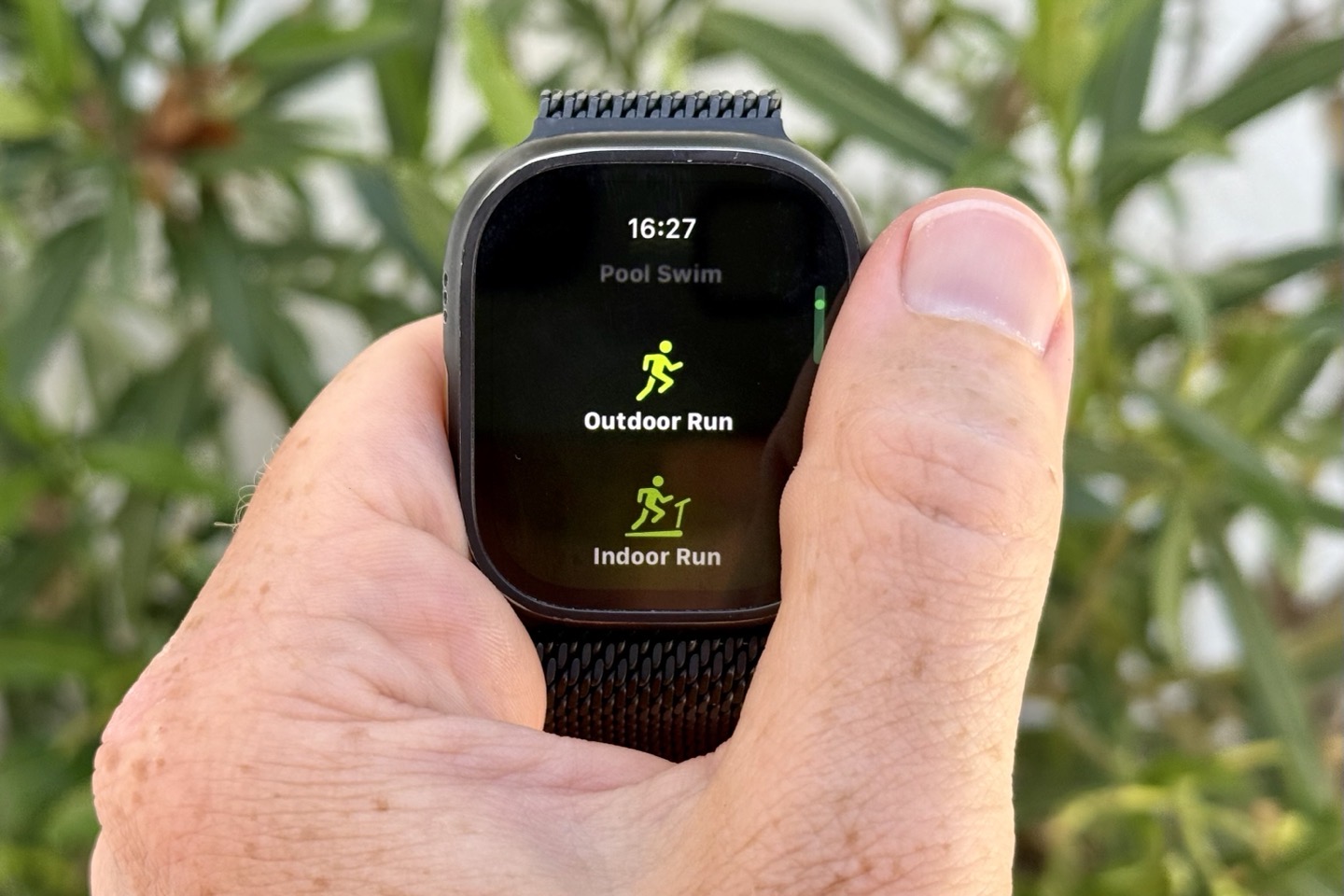
In any case, in the four corners, you’ll now find the four buckets of stuff that have been logically grouped together.
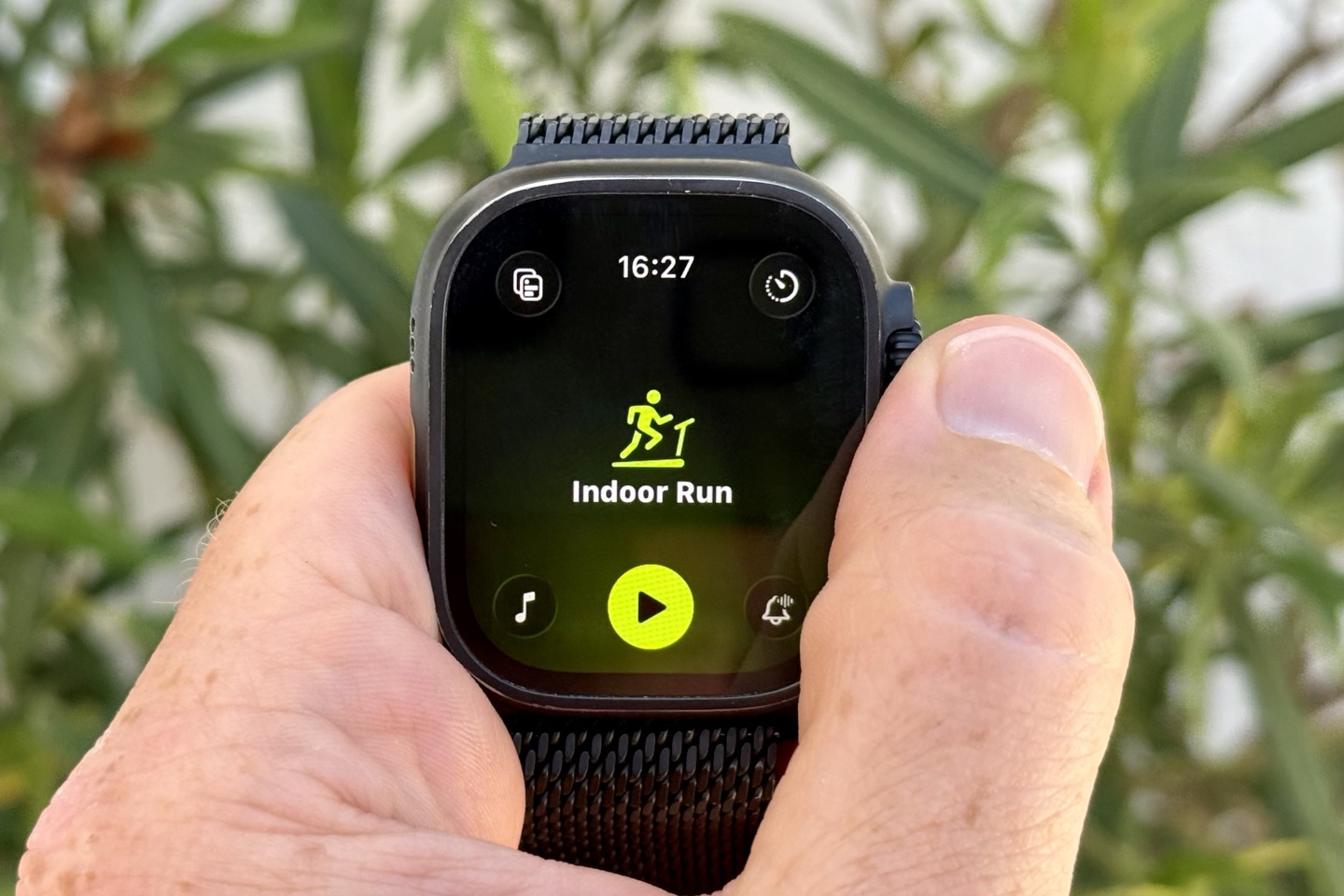
Previously this was sorta messy, whereas now, this grouping makes sense:
Upper left: Workout Views (aka your data pages/settings)
Upper right: Workout goals & structured workouts (aka the different ways you can have the watch tell you to suffer)
Lower left: Music (all things music)
Lower right: Workout Buddy & Voice Alerts (thus, all things voice-over related)
I’m good with this, and this makes a ton of sense, so kudos here.
In terms of features like the Workout Views, once within this, they haven’t changed from the past. And the same goes for Workout Goals/Structured Workouts. All of it is the same.
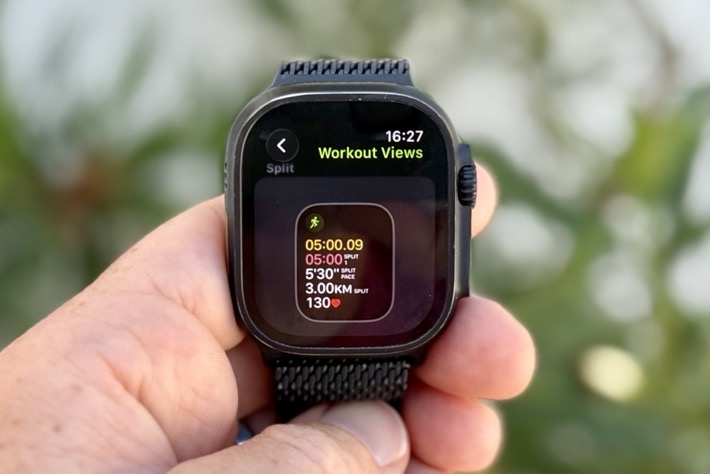

Whereas Music is changed, and there’s now a new option “Picked for You”, which will automatically create a playlist on the fly for you (or you can automatically start an existing playlist). This new playlist on the fly feature is leveraging Apple Music, and aims to automatically match the type of workout – such as HIIT with a high energy, versus Yoga will be more chill. It does not use awareness of structured workouts, etc, just the overall sport type.
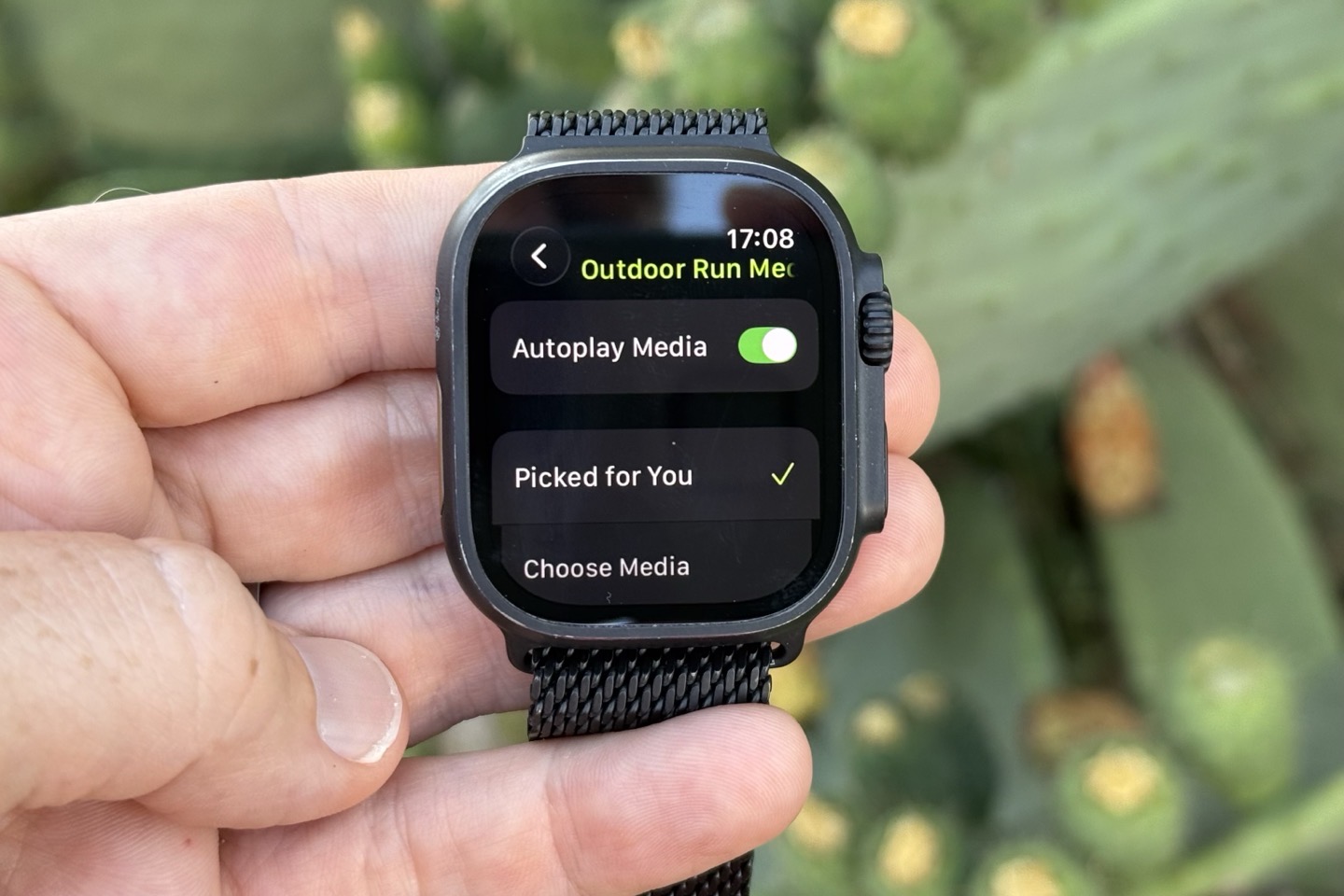
In my use of this over the last little while, mostly on runs, the playlists varied between “holy crap that was great” to “totally missed the mood”. For example, last night, on a trail run right at sunset, the songs as the sun was disappearing into the ocean were spot on. Almost ethereal, matching the beat of the running cadence. However, about 10-15 minutes later, the music took on a totally different vibe-breaking mood, going towards hardcore rap. And while music is obviously very personal, these two didn’t seem to fit together on the same automatically generated playlist.
And while I’d be happy to tell you the names of the songs, I can’t do that either. It doesn’t show/record these anywhere that I can find, as they don’t appear to show up either in the Apple Fitness app on your phone, or even the Apple Music app as historically played songs. Seems like an opportunity to list these within the Apple Fitness workout summary pages somewhere
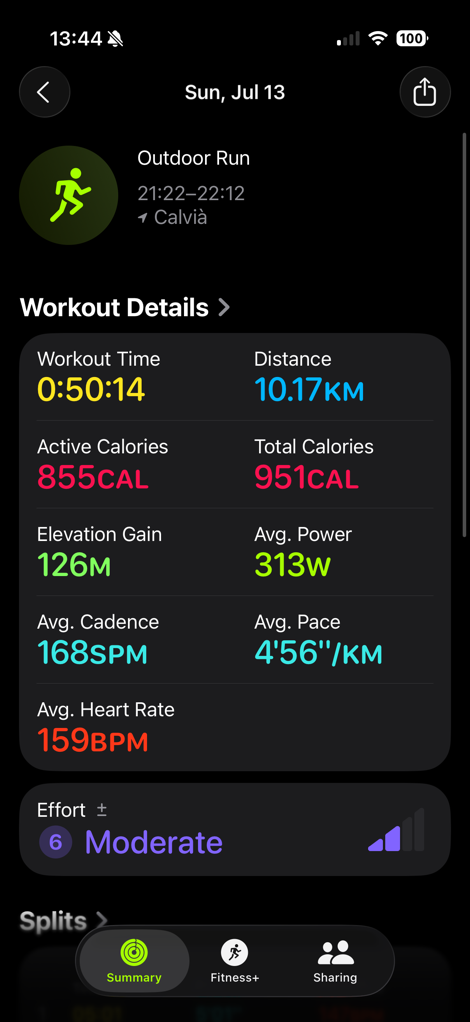
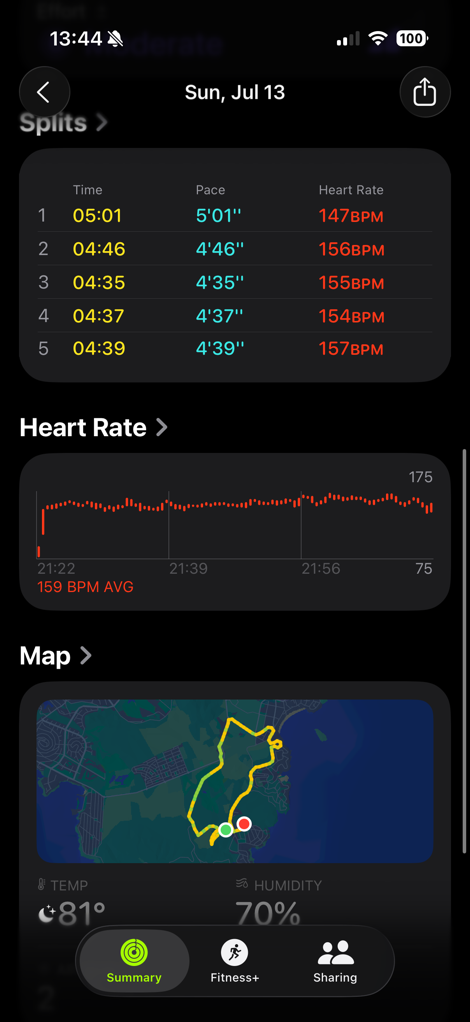
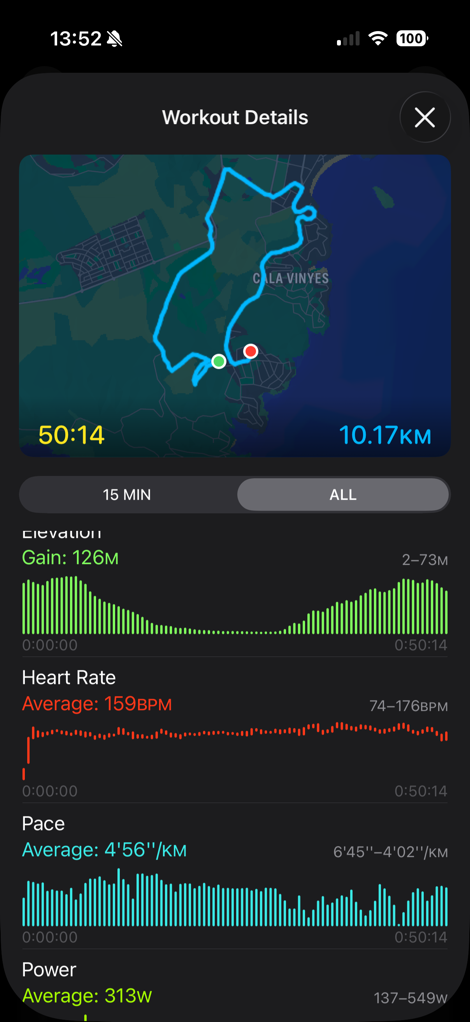
In any case, as I said above, when the music was good, it was really good. I just wish I knew what half the songs were later on.
Workout Buddy:
Finally, we get to Workout Buddy, the headliner feature of WatchOS 26. This is designed to basically take an Apple Fitness+ trainer, and bring them along with you on a workout. The two voices are literally modeled after two Apple Fitness+ trainers today, Sam Sanchez (women’s voice) and Jamie-Ray Hartshorne (male voice), and it sounds like this will probably grow in the future with more voice options.
In any case, to get things started, you’ll need to enable it in the lower right corner, in the same place you enable other alerts:
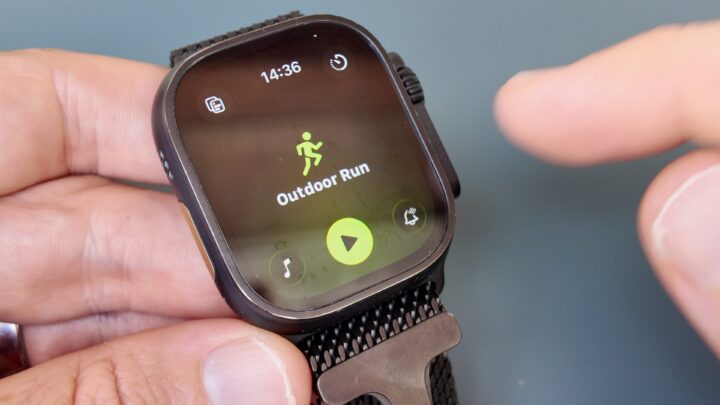
You can enable Workout Buddy on a per-sport profile basis, and then choose the voice for each workout type. Workout Buddy is available on the following sport profiles:
– Outdoor Run
– Indoor Run
– Indoor Walk
– Outdoor Walk
– Outdoor Ride
– Indoor Ride
– High Intensity Interval Training
– Traditional & Functional Strength Training
– Hiking
– Elliptical
– Stair Stepper
This list has expanded since launch, where Indoor Ride and a few others weren’t supported, but now are. Additionally, you can change the voices, which are simply listed as Voice 1 and Voice 2. Additionally, I’m now getting a Voice 3 listed that’s female but sounds similar, yet not quite the same as Sam Sanchez. Unclear what this is.
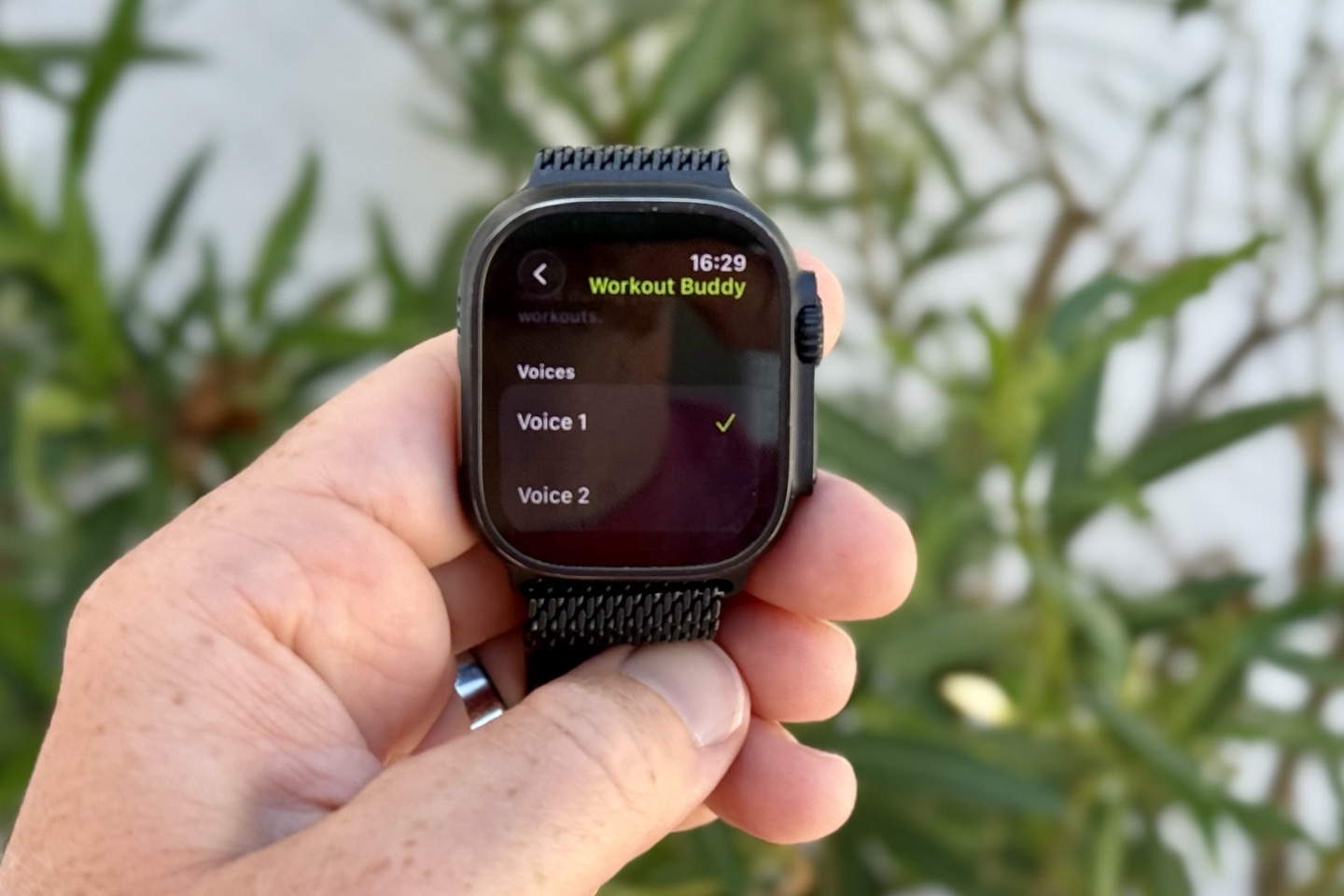
In any case, for Workout Buddy, there are four other requirements:
1) You must have a compatible Apple Intelligence phone paired to it (iPhone 15 Pro/Pro Max series, or all iPhone 16 series phones)
2) That phone *MUST BE* within range of your watch at all times during the workout
3) The phone *MUST* also be connected to the internet the entire time
4) You *MUST* have headphones on, as Apple is concerned that broadcasting your fitness/activity stats using the watch speaker could be a privacy issue
What you quickly realize when using this is that Apple Intelligence isn’t actually on the watch at all. WatchOS 26 is not actually bringing AI onto your watch. Or at least, not doing the processing on your watch. Instead, everything is done either on the phone or in the cloud. Apple is leveraging its Private Cloud Compute for Workout Buddy, in conjunction with additional information the watch supplies to the cloud, in order to create the voice tidbits we’ll get into later.
This means that if you don’t have internet access (such as during portions of my trail runs), you won’t get any Workout Buddy insights, or even any splits/lap alerts (in moments I was without coverage, they went totally unannounced). And of course, bigger than that, it means you must run with your phone. While taking your phone for rides or to the gym isn’t a big deal, many people prefer not to run with their phones.
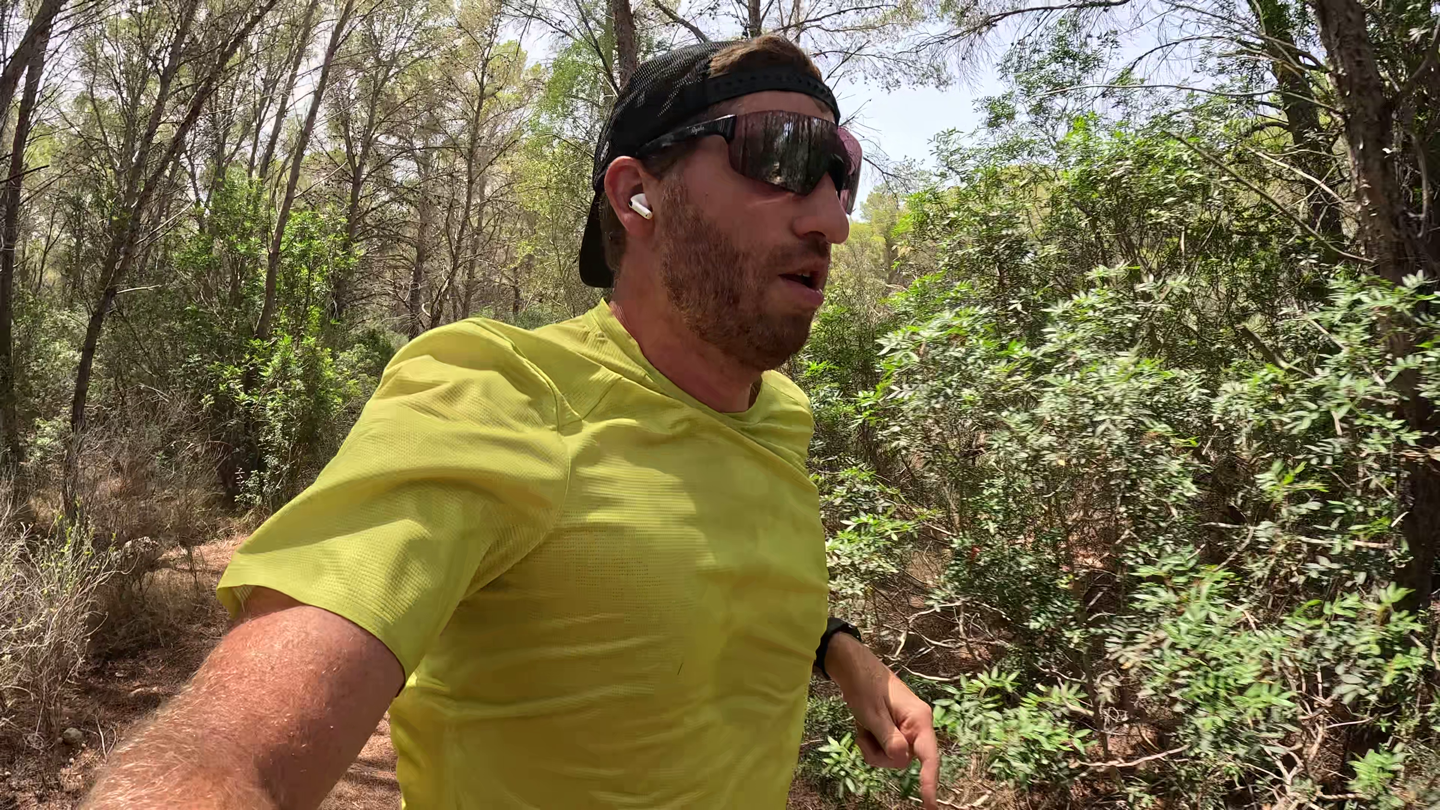
In any case, with all that set, let’s move on to the actual workout. The moment you press start, your workout will start as normal. In my case, using the new automagic playlist feature, the music starts within about 1-2 seconds. Then, at about the 13-16 second marker, the music ducks down, and the Workout Buddy voice comes in. This piece is called the Pep Talk, and is designed to set the stage for the workout.
Last night, on my trail run, it started off saying:
“Way to get your Sunday Evening Run going, you’re on track to close your rings every day this week”, and then it went on to say “you’ve closed your move rings every day for the last 16 days”, followed by a brief mention of the music artists name that was playing.
What was interesting here, though, was the specific mention of “16 days”. But that’s odd, because my Move Ring streak is actually at 307 days. So why on earth would you mention 16 days? Later at the end of the workout, it would actually mention the full/correct streak, but this seemed like the perfect/classic example of a weird generative AI quirk.
Generally speaking, for the Pep Talk portion of Workout Buddy, it tends to make note of the day of the week (and notably if it’s the first/last/x # run/workout type of the week), followed by some status of my move rings.
Another example, from this morning’s ride, as I got started:
“Way to start the week with a cycling workout! Last week you punched it by reaching a total distance of 91.2KM of cycling workouts. Your 7 day training load is well above your 28 day baseline. Now hop on the saddle and enjoy [artist name].”
On another ride, it somewhat quirkily stated, “You’ve cycled 24,000 minutes this year thus far”. It was the usage of “minutes” that I found…special. I’ve never heard anyone give annual cycling stats in minutes before.
Here’s another, from the start of a run this afternoon:
“Way to start your Monday run with some upbeat tunes, you’ve already crushed your move and exercise rings today. You’ve also set your longest move streak ever, with 307 days yesterday. Your 7-day training load is well above your 28 day baseline. Let’s get moving!
In any event, as you’re running along (or any sport you’re doing), you’ll get any alerts you’ve configured in that Workout Buddy voice, as well as random Milestones. Milestones also include any closing of rings (the moment it happens).

The Milestones were sprinkled throughout the run. I got one that I had closed all my rings for the day (but skipped on telling me that I had thus completed another perfect week). And then another announcement at the exact moment I crossed over as the longest run for the week (it has been a much heavier ride/swim period the last few weeks, and included one longer run the Apple Watch didn’t go on).
Additionally, it’ll tell me elevation gain on some of my splits, if it’s notable. About 9 out of 10 times, the lap splits works well. For example, yesterday on my 15km run, most of the lap splits were perfect. Except, one was bizarre. At the 11km marker it said (slightly paraphrased):
“You’ve just crossed 11 kilometers, in a time of 47 minutes”.
Except here’s the thing: The timer was currently at 62 minutes on this trail run. Meaning, it flat-out just made up a time, and hoped for the best. On the next split (12km), it was spot-on again. Yet, at 14.25km, when I briefly paused the timer, it gave me a short update message, but said “You’ve got 13.9KM to your name”. Like, where’d the other 300m go?
Overall, during the workout, Apple is clearly aiming to sprinkle in ‘surprise and delight’ tidbits, and it does that to an extent, but much like many generative AI attempts in fitness, when push comes to shove, sometimes, these sprinkles just don’t make a lot of sense. At one point, for example, during a run, it said (paraphrased) “You closed all your Activity and Stand rings last week”, except I actually closed all my rings last week (including the unmentioned Move). Why wouldn’t it just say that? No human would phrase it that way.
In any case, once your workout is done, then you’ll get the ‘Walk off’, which will occur after you end the workout, and typically after you’ve been on the workout summary screen for about 8-10 seconds. These will include a short overview of the workout, as well as some other context overall.
Here’s an example after dropping off the kids at summer camp this morning via bike:
“Nice job on your outdoor cycling session. You cycled 17.2 kilometers in 49 minutes and 12 seconds, with an average speed of 21KPH, and you closed both your move and exercise rings. Enjoy the rest of your Monday!”
There’s a few more of these in my video above.
Generally speaking, my experience has been that the summary/Walk-Off generative AI insights have actually been the best of all the insights it gives. As in, it rarely says wonky things, and typically does a good job at summarizing things. It’s almost like the Workout Buddy is rushing to get the Pep Talk/mid-workout snippets done, and makes mistakes, whereas the completion ones, it takes its time to get it right.
Going Forward:

From here, we still have roughly two months until WatchOS 26 is released, on both new and existing watches alike. And as Apple has shown each summer, many things are likely to change by the time that happens (usually for the better, though sometimes certain things do stay as-is).
Overall, WatchOS 26 for sports/fitness seems like a relatively minor update compared to the gauntlet of sports/fitness updates we saw over the previous three to four years. Whether or not that holds true in September remains to be seen, of course.
Looking at the Workout Buddy in particular, it’ll be interesting to see if Apple can solve some of the hallucination pieces. The state of the industry at large, both AI as well as sports tech companies leveraging AI, simply says we aren’t there yet. The majority of AI insights that companies like Garmin, Strava, Whoop, Amazfit, and others have delivered have been ‘iffy’ or ‘shrug’ at best.
Part of the challenge these companies face, as more than one of them has noted to me, is that they’re *heavily* erring on the side of caution and optimism, to the point it becomes a hindrance. One company stated that they’d much rather give you bland and useless insights than tell you outright mean/wrong/dangerous things. Meanwhile, Apple has put in place strict guardrails for Workout Buddy, which drives it towards positivity (rather than proudly announcing “That was your slowest mile to date”).
At the same time, where I see the most potential for Workout Buddy is actually removing some of those guardrails with certain voices (characters/emulations). One of the core reasons that certain Peloton instructors have gathered celebrity-like status is because they are more abrasive in their coaching style, and for many athletes, having a pushier coach/trainer can yield better results. Certainly, Apple knows this already (to an extent) with Apple Fitness+, though I think we’d all objectively agree that Apple’s instructors are almost uniformly erroring on positivity, whereas Peloton has a wide range of ‘constructive criticism’ personalities.
Ultimately, it’s a question of how far the company is willing to allow for more flexibility in those messages. It’s perfectly fine to say, “While that was your slowest mile on this run, you also gained a massive amount of elevation, so don’t worry about it.” And it’s equally fine to say at the end, “This run was slower than your recent runs, but your training load is 128% higher than your 28-day average, perhaps some recovery is in order.”
The whole point of AI is to help or nudge an athlete, not to simply regurgitate stats they can easily see themselves. If Apple can succeed in doing so in the future, then Workout Buddy will likely become quite popular. Overall, I really do like the direction, I just want to see some of the obvious errors removed.
With that – thanks for reading!
FOUND THIS POST USEFUL? SUPPORT THE SITE!
Hopefully, you found this post useful. The website is really a labor of love, so please consider becoming a DC RAINMAKER Supporter. This gets you an ad-free experience, and access to our (mostly) bi-monthly behind-the-scenes video series of “Shed Talkin’”.
Support DCRainMaker - Shop on Amazon
Otherwise, perhaps consider using the below link if shopping on Amazon. As an Amazon Associate, I earn from qualifying purchases. It doesn’t cost you anything extra, but your purchases help support this website a lot. It could simply be buying toilet paper, or this pizza oven we use and love.

















Re: Workout/run data.
Has the workout data been updated? Specifically work/energy for a run/hike?
IME, the caloric count from Apple workouts isn’t based on anything close to reality. I’ve found that it is typically ~4x what I get from other devices (Stryd) or what I would expect based on cycling power meters.
I’m not aware of any changes there.
Looking at yesterday’s 15KM trail run:
Apple Watch Ultra 2: 1,438cal
Garmin Venu X1: 1,443cal
Whoop 5 MG: 1,106cal
And then a 4hr 17min ride last week in the mountains:
Apple Watch Ultra 2: 2,344cal
Garmin Venu X1: 2,583cal
Whoop 5 MG: 2,384cal
I’d say that if you’re getting 4x the calories, then it sounds like maybe your weight is specified wrong?
Is it kilojoules? I kcal = 4 kj approx.
Yes, but the body is about 25% efficient, so the number of kJ is roughly the number of Calories actually burned to produce that power.
Interesting. Apple Fit appears to be over writing data from the Garmin file. For today’s ride, my Garmin file says it was 583 kJ. The Garmin file in Apple Fit shows almost 2,500 kJ for the ride.
Where are you seeing these numbers? If I look in Health at my ride today, in Workouts I see 783 C from Strava, which agrees exactly with the number from Strava itself, and 631 C from Connect, which doesn’t agree with the calorie number from Connect (783 there), but does agree with the 631 kJ total work on both. Today’s ride was done on my eMTB with my Edge 1040 recording, which is the only outdoors bike I have with a power meter. It’s fairly common to just use the kJ number from a power meter as a better estimate for C than some HR based algorithm, because, as I said, the body is about 25% efficient in generating power at the pedals and the power number is an actual measurement. For yesterday’s ride, also on the 1040, done on my road bike so with no power meter, both say 1216 C, and Connect doesn’t even have a kJ number (can’t measure it without a power meter), although Strava gives an estimate. That’s what Health also says for the workout, and Fitness agrees with Health for every workout, as expected. My Ultra, as usual, was at home on its charger during the ride. Are you recording with 2 devices?
I’m seeing them in Apple Health and Apple Fitness.
I don’t use Strava.
But where? For the single ride in Workouts? 2500 kJ looks like a total day number, including metabolism, whereas 583 kJ looks like a single ride number. A couple of years ago Garmin changed it’s calorie numbers to include metabolism during the ride, (before they just reported their estimate of calories burned because of the ride) but that’s usually on the order of 100 C per hour or so. So if you’re seeing 2500 kJ, that really looks like an entire day number, not just the ride.
Apple Health > Workouts
Apple Fitness > Sessions
Screen grabs attached. Looks like I can only add 1 screen grab. This one is Apple Health.
Apple Fitness
Truly weird. For that ride, I’d expect something on the order of 600 C. That looks like one of my daily rides with a bit less climbing. Where is Apple getting the 2500 kJ from? It’s not doing that to me, or evidently to Ray. Maybe as Ray suggests check your weight? Fitness gets mine from my Withings scale, and I try to remember to weigh in before every ride. Maybe there’s a setting somewhere that’s messed up?
“For that ride, I’d expect something on the order of 600 C. That looks like one of my daily rides with a bit less climbing.”
Exactly.
“Where is Apple getting the 2500 kJ from?”
I’ve no f’ing idea. I weigh daily and it’s entered into various app’s – including Apple Health.
I do not see the issue. 600 kcal is around 2,500 kJ, so the numbers are very close/the same (4.184 kJ/kcal) and look normal as energy consumer/calories burned for that workout.
The 25% efficiency/conversion ratio is a good guideline but should be irrelevant – it only comes into play if including total work in the analysis.
@dkrenik: Is the 583 kJ from Garmin Connect the “Work” (under “Power” in the “Stats” tab for the activity – kJ suggests that and it appears roughly consistent with the other stats from the screen shot) or “Active Calories”/”Total Calories” (under “Nutrition & Hydration” in the “Stats” tab)?
Ahh, so it may well be a setting, choosing kJ as your unit. There’s a difference between work done during the activity measured by a power meter at the pedals and total energy expended in your muscles. which is usually just presented as calories burned. But you’re right, 600 C \sim 2400 kJ. So Apple gets the number by using kJ rather than C, and Connect only displays the kJ measured by the power meter.
kJ and kcal are just different units for energy.
The question is what metric is being reported/what metric dkrenik is looking at – in the original post s/he appears to conflate “caloric count” for the workouts with work from from power meters.
People generally (want to) track the amount of kcal or kJ consumed (“burned”) during an activity and that is basically what all health and fitness apps (Apple Health, Apple Fitness, Garmin Connect, Strava, etc.) show.
Only very rarely would one look at the total “effective” work done during an activity – although it can be measured/calculated or estimated (e.g., based on power).
As you note, the ratio for these tends to be ~25%. And the numbers shown by dkrenik are totally consistent with that:
600 kcal (2,500 kJ) looks like a totally reasonable estimate for a “total energy expended/burned” during a 19 mile/30km in 1h20mins at 111bpm heart rate. -> This is what I would expect to see in Apple Health, Apple Fitness, Garmin Connect, Strava, etc.
And ~150 kcal (~625 kJ) a totally reasonable number for “work done” at the crank (as seen by the power meter) for such a workout. -> I would expect to see that (but not really use it for anything) in the power date from Garmin Connect/the PM.
A small offtopic tip – Reminders in iOS has had built-in shopping lists (with auto-categorization and other features) for quite a while. And it works on Apple Watch right now, no need to wait for September or install a beta.
I’m still waiting for the pivotal feature where Apple lets users rename activities in Apple Health just like Garmin Connect does.
When I review my workouts, I want to know exactly when I trained chest, triceps, shoulders, back, or biceps. I also want to tag the name of the lake where I swam, rename my runs, and label rides based on route or purpose (e.g, Zone 4 effort, climbing with Mike, crushing PR’s at Mt. Rainier).
Generic, hardcoded activity titles from Apple feel like 20-year-old technology 😄
Another awesome and complete review. Thank you.
The big disappointment for me: To use Workout Buddy on your Apple Watch, you must have your iPhone in range 💣. Whoa?!.
The reason I bought my Apple Watch was so I could leave my phone at home while still staying connected. I listen to music and books, send and receive messages, make and take phone calls along all while recording workouts on my untethered watch. I was initially surprised that apps like Varia Radar and a pacing metronome were unavailable for the Apple Watch, so I wrote my own (never doubt a retired software developer with vibe coding tools 🤣). All this to say, my Apple Watch is a comprehensive *standalone* fitness device.
At last year’s WWDC, Apple made a big deal about using their private cloud to offload AI tasks. Workout Buddy would appear to be the prefect use case. Not requiring a tethered phone would differentiate Apple from Garmin that needs a connected phone for many features including recent subscription-based services.
My (small) hope is that the new hardware this fall will support this untethered. Might be a good differentiation for the Ultra since it’s been two years since much changed there.
What Garmin features (aside from the subscription stuff) require a phone? All of Garmin’s training stuff are on-device so the phone’s not required for virtually any of it unless you do a set coaching plan as opposed to daily suggested workouts.
Garmin Live Track features require a connected smartphone.
link to support.garmin.com
That’s not a training stuff. But feature that requires sending location via internet. And as you probably know there is no cellular option for Garmin watches.
Apple always always defaults towards hiphop music if given enough songs played.
Does Workout app finally track distance for outdoor activities like cross country skiing etc?
Yes, since WatchOS 11 distance tracking has been added to skiing, skating and water sports (paddling). Plus maybe a couple more I’m missing.
I have zero interest in someone babbling in my ear while working out, but I might actually use it if it was sarcastic: “Pick up the pace, fatass!”
:D
„ The nearest McDonald’s is 8 miles away, shall we start a running activity?“
And at the end of the route there is of course no McDonald’s but a doctor for stomach reduction or a mortician.
That would be a really nasty training buddy ;D
“Way to start your Monday run with some upbeat tunes, you’ve already crushed your move and exercise rings today. You’ve also set your longest move streak ever, with 307 days yesterday. Your 7-day training load is well above your 28 day baseline. Let’s get moving!”
Some call it AI, some call it a Magic 8 Ball with various insert PARAMETER statements.
Was hoping the music control change would finally bring something like this to real world devices:
link to dcrainmaker.com
“This new playlist on the fly feature is leveraging Apple Music, and aims to automatically match the type of workout – such as HIIT with a high energy”
I for one cannot wait to have a Z1 recovery ride soundtracked out of my Apple Music library with 60 minutes of Eagles of Death Metal, Royal Blood, Idles, and Mad Foxes … simply because the activity is set to “Indoor Cycling” and “Indoor Cycling” means high aerobic spin class, right?
My Strava feed is full of the best runners, road cyclists, and mountain bikers of my area. The number of people using an Apple Watch for training: Zero! Not a single one. Even at running and MTB competitions, I only ever see Garmin, Suunto, and Polar. For ambitious athletes, the AW is still unattractive, probably because of its pathetic battery life. Or it’s the many features that actually distract from training.
Hi Ray,
Could you shed some light onto the following:
* How does the workout buddy work with the structured workouts? Does it announce the intervals or does it do some interval-related announcements in general?
* Given that cellular Apple Watch technically is connected to the phone wherever cellular is available, does it mean that Workout Buddy will work even if your phone stays at home (provided that you run in places with good cell coverage)?
Seems as useful as Strava Athlete intelligence.
Definitely not making me want to move from Garmin to Apple. Garmin gives me all that information in a screenshot that I read in 2 seconds.
I HATE that all these AI’s never say anything negative. I want to know if my HR was unusually high for my pace if there was no huge elevation change. Or if I am slowing down towards the end of a run but my HR is also lower so I could speed up etc etc. I don’t need constant validation from my watch, I need actual feeback,
Thank you for the excellent write-up! I am excited to try this feature out tonight, but dismayed to see that it requires my phone to be with me. That may be a deal-breaker in the long run, but I’ll try it out a couple of times just for fun.